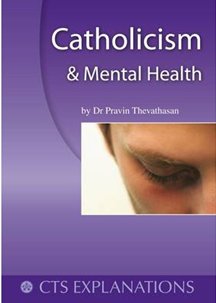Catholic Medical Quarterly Volume 64(3) August 2014
Book Review
Catholicism and Mental Health
Catholic Truth Society, London. 2014.
by Pravin Thevathasan
ISBN
978 1 86082 9185
 This
work sets out to explain why there should not be any conflict between
Catholicism and Psychiatry. By providing an overview of contributions made
by Catholics, including figures such as Johann Weyer and Juan Luis Vives,
it shows how Catholics have supported and made significant contributions
to mainstream medical models of understanding, classifying, and treating
mental disorders.
This
work sets out to explain why there should not be any conflict between
Catholicism and Psychiatry. By providing an overview of contributions made
by Catholics, including figures such as Johann Weyer and Juan Luis Vives,
it shows how Catholics have supported and made significant contributions
to mainstream medical models of understanding, classifying, and treating
mental disorders.
It shows that the Church has encouraged the use of medical treatment as part of the management plan for patients presenting with mental illness, whilst still expressing caution at a purely medical approach that excludes acknowledgement of the spiritual factors that also need to be considered. The author’s own willingness as a Catholic to explain that there are sometimes biological and environmental causes to mental illness highlights the shared beliefs that a Catholic can hold with the medical model of mental illness.
The tragedy of the witch hunts is briefly touched upon and acknowledged as a misguided action by those who were part of it within the Church. However, it inspiringly educates the reader about the significant care and advocacy role that some Catholics had towards people suffering with mental illness during the period of the witch hunts, contrary to what is commonly reported. Key Catholic figures who opposed the trend such as St Vincent De Paul are brought to attention. One cannot help but be particularly impressed by the parallels between St Vincent’s method of treating the mentally ill, and the interventions and life style factors considered to be effective for mental health recovery today. Examples are given of how the incorporation of Catholic spirituality into the management of people with mental illness produces beneficial effects for their symptoms and illustrates good care. For example a case study is used to highlight the effect of the Sacrament of Reconcilliation on alleviating guilt.
To further support the assertion that there should not be conflict between Catholicism and Psychiatry, data is presented that suggests that that there is synchrony between the values that Catholicism promotes, for example with respect to family life and sexuality, and what mental health research demonstrates.
Whilst the overall aim of this book is to illustrate the positive relationship that exists between Catholicism and Psychiatry, contradictory evidence to this assertion is also brought to the reader’s attention in the section on “When Psychiatry and Catholicism Conflict.” Here the lives, psychological theories, and personal belief systems of Carl Jung and Sigmund Freud are discussed, as well as apparitions and mystical experiences.
This work has several implications for Christians and non-Christians alike. For Christians, it highlights the significance of evidence based medical and psychological treatments as management options for people suffering with serious mental illnesses such as depression and schizophrenia. For non-Christians, especially those working in the field of mental health, it raises an important question about the significant role that Catholic spirituality can play in healing somebody during a period of mental suffering. It also challenges stances that the Church holds unscientific beliefs about the causes of mental illness and that the early Church’s only position on what causes mental illness was one of demonic possession.
The author should be commended on the brevity of the work, which makes it accessible to the busy clinician or clergyman who may not have time otherwise to read a detailed thesis on the conflicts and similarities between Catholicism and Psychiatry. The inclusion of a range of references used is suggestive of the author reviewing the literature surrounding this topic to inform some of his opinion.
It would have been helpful to have further examination of the conflicts or similarities that arise between Catholicism and the psychotherapies that stem from Freud and Jung’s theories, rather than mainly focusing on the theories themselves. Furthermore, it would have been interesting to examine the ‘positive psychology’ movement and to explore whether there are commonalities between its thinking and a Catholic spirituality, perhaps focusing on theories by key psychological figures in this movement, for example Martin Seligman. I would also have been interested to read a synopsis on the psychoanalyst, Donald Winnicott, whose concept of the ‘good-enough mother’ is referred to a lot in psychiatric training, and whether there are commonalities between this concept and a Catholic understanding of good parenting.
In my opinion, this work will begin to alleviate some of the suspicions that can exist amongst non-Christians working in the mental health field towards Christianity, and amongst Christians’ towards psychiatric treatment, but will also serve to highlight areas of mental health, e.g. theories underpinning interventions, that may not be fully compatible with Christian belief. It also makes a good attempt to highlight some of the conflicts that arise when human experience is reduced to a purely biopsychosocial model of understanding and the reality of supernatural experience is neglected. Although not stated by the author as an intention of his writing, this book encourages good psychiatric practice by highlighting the need to consider the whole person when treating a patient, by adopting a biological, psychological, social and spiritual approach to care. It would appeal to anybody working in the mental health field, particularly psychiatrists, psychotherapists and psychologists, to clergymen and religious, and to the lay person interested in the area of mental health and spirituality.
